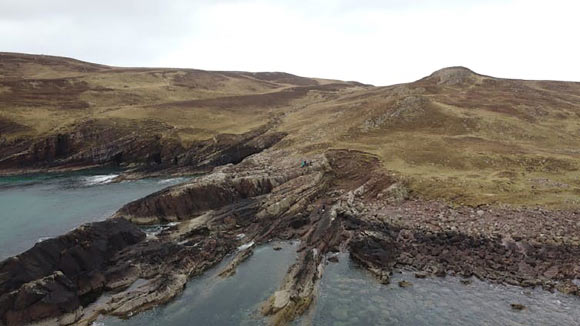This apex predator is a type of sebecid crocodyliform with South American origins, according to new research led by the Florida Museum of Natural History.
Sebecid crocodyliforms dominated South American landscapes after the extinction of dinosaurs until about 11 million years ago. Image credit: Jorge Machuky.
Sebecids were the last surviving members of Notosuchia, a large and diverse group of extinct crocodilians with a fossil record that extends back into the age of dinosaurs.
They represented a wide range in size, diet and habitat and were notably different from their crocodile relatives, as most of them lived entirely on land.
Sebecids acted like carnivorous dinosaurs, sprinting after prey on their four long, agile limbs and tearing through flesh with their notorious teeth.
Some species could reach 6 m (20 feet) in length and had protective armor made of bony plates embedded in their skin.
The end-Cretaceous mass extinction that wiped out non-avian dinosaurs nearly destroyed notosuchians as well.
In South America, only the sebecids endured, and with the dinosaurs gone, they quickly rose to be the apex predator.
The open sea separating the Caribbean islands and mainland South America would have posed a serious challenge for a terrestrial sebecid to swim across.
In the new study, Florida Museum of Natural History paleontologist Jonathan Bloch and his colleagues examined a 6-million-year-old fossilized tooth and vertebrae of a sebecid crocodyliform collected at the locality of Paleo Pond 1 on Sabana Grande de Boya, the Dominican Republic.
“The first question that we had when these teeth were found in the Dominican Republic and on other islands in the Caribbean was: What are they?” Dr. Bloch said.
The authors also studied 18 million-year-old teeth from Cuba and a 29-million-year-old tooth from Puerto Rico.
“In finding the fossils, we revealed possible evidence in support of the GAARlandia hypothesis,” they said.
“This theory suggests a pathway of temporary land bridges or a chain of islands once allowed land animals to travel from South America to the Caribbean.”
“If, the serrated teeth discovered on other Caribbean islands also belonged to a sebecid, the history of these giant reptiles extends beyond the Dominican Republic.”
“They would have occupied and shaped the region’s ecosystems for millions of years. Yet today you’d be hard-pressed to find evidence of the large terrestrial predators.”
“In their absence, smaller endemic predators like birds, snakes and crocodiles have evolved to fill the gap in the food chain.”
“You wouldn’t have been able to predict this looking at the modern ecosystem,” Dr. Bloch said.
“The presence of a large predator is really different than we imagined before, and it’s exciting to think about what might be discovered next in the Caribbean fossil record as we explore back further in time.”
The team’s paper was published in the Proceedings of the Royal Society B.
_____
Lázaro W. Viñola López et al. 2025. A South American sebecid from the Miocene of Hispaniola documents the presence of apex predators in early West Indies ecosystems. Proc. R. Soc. B 292 (2045): 20242891; doi: 10.1098/rspb.2024.2891
























